6 Registers and RAM
6 寄存器&内存
Hi, I'm Carrie Anne and welcome to Crash Course Computer Science.
嗨,我是CarrieAnne,欢迎收看计算机科学速成课
So last episode, using just logic gates, we built a simple ALU,
上集,我们用逻辑门做了个简单ALU
which performs arithmetic and logic operations, hence the 'A' and the 'L'.
它能执行算术(Arithmetic)和逻辑(Logic)运算,ALU里的A和L因此得名
But of course, there's not much point in calculating a result only to throw it away
当然,算出来之后如果扔掉就没什么意义了
it would be useful to store that value somehow,
得找个方法存起来
and maybe even run several operations in a row.
可能还要进行多个连续操作
That's where computer memory comes in!
这就用到计算机内存了
If you've ever been in the middle of a long RPG campaign on your console,
如果你在主机上打过一场长时间的对局
or slogging through a difficult level on Minesweeper on your desktop,
或玩困难模式的"扫雷"
and your dog came by, tripped and pulled the power cord out of the wall,
然后狗跑过来,被电源线绊倒,把插头拔了出来
you know the agony of losing all your progress.
你知道失去进度的痛苦
Condolences.
真同情你:(
But the reason for your loss is that your console, your laptop and your computers
你损失数据的原因是,
make use of Random Access Memory, or RAM,
电脑用的是"随机存取存储器",简称"RAM"
which stores things like game state as long as the power stays on.
它只能在有电的情况下存储东西,比如游戏状态
Another type of memory, called persistent memory, can survive without power,
另一种存储(memory)叫持久存储,电源关闭时数据也不会丢失
and it's used for different things;
它用来存其他东西.
We'll talk about the persistence of memory in a later episode.
我们之后会讨论存储(memory)的持久性问题
Today, we're going to start small
今天我们从简单开始
literally by building a circuit that can store one.. single.. bit of information.
做只能存储1位的电路
After that, we'll scale up, and build our very own memory module,
之后再扩大,做出我们的内存模块
and we'll combine it with our ALU next time, when we finally build our very own CPU!
下次和ALU结合起来,做出CPU!
All of the logic circuits we've discussed so far go in one direction
我们至今说过的电路都是单向的
always flowing forward.
总是向前流动
like our 8-bit ripple adder from last episode.
比如上集的8位"脉动进位加法器"
But we can also create circuits that loop back on themselves.
但也可以做回向电路,把输出连回输入
Let's try taking an ordinary OR gate, and feed the output back into one of its inputs
我们拿一个OR门试试,把输出连回输入
and see what happens.
看看会发生什么
First, let's set both inputs to 0.
首先,两个输入都设为0
So 0 OR 0 is 0, and so this circuit always outputs 0.
0OR0是0,所以电路输出0
If we were to flip input A to 1.
如果将A变成1
1 OR 0 is 1, so now the output of the OR gate is 1.
1OR0为1,所以输出1
A fraction of a second later, that loops back around into input B,
一转眼的功夫,输出回到B
so the OR gate sees that both of its inputs are now 1.
OR门看到两个输入都是1
1 OR 1 is still 1, so there is no change in output.
1OR1仍然为1,所以输出不变
If we flip input A back to 0, the OR gate still outputs 1.
如果将A变成0,OR门依然输出1
So now we've got a circuit that records a "1" for us.
现在我们有个电路能记录"1"
Except, we've got a teensy tiny problem this change is permanent!
然而有个小问题:这是永久的!
No matter how hard we try, there's no way to get this circuit to flip back from a 1 to a 0.
无论怎么试,都没法从1变回0
Now let's look at this same circuit, but with an AND gate instead.
我们换成AND门看看会怎样
We'll start inputs A and B both at 1.
开始时,A和B都设1
1 AND 1 outputs 1 forever.
1AND1永远输出1
But, if we then flip input A to 0, because it's an AND gate, the output will go to 0.
如果之后A设为0,由于是AND门,输出会变成0
So this circuit records a 0, the opposite of our other circuit.
这个电路能记录0,和之前那个相反
Like before, no matter what input we apply to input A afterwards, the circuit will always output 0.
就像之前,无论A设什么值,电路始终输出0
Now we've got circuits that can record both 0s and 1s.
现在有了能存0和1的电路
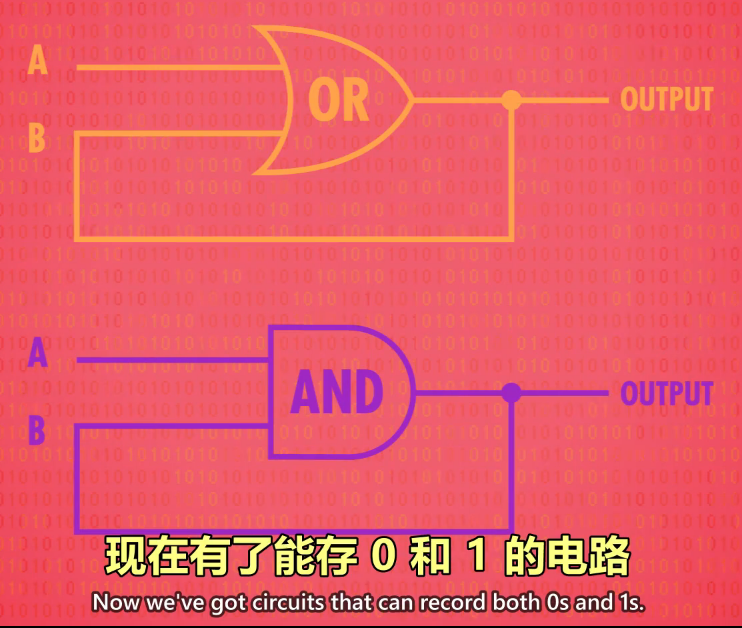
The key to making this a useful piece of memory is to combine our two circuits into what is
为了做出有用的存储(memory),我们把两个电路结合起来
called the AND-OR Latch.
这叫"AND-OR锁存器"
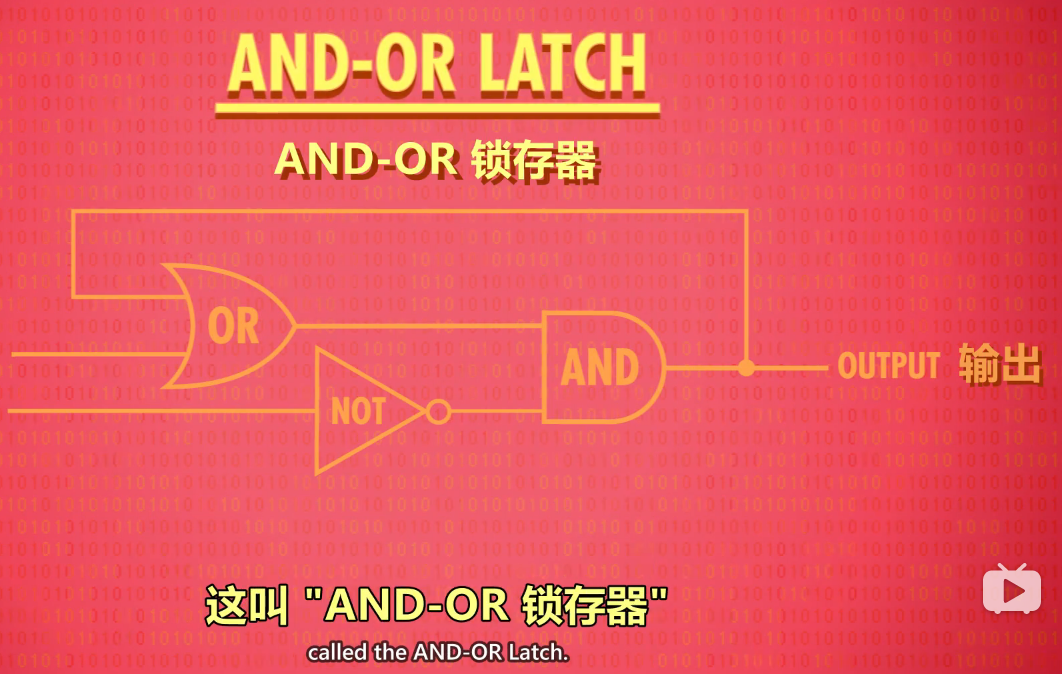
It has two inputs, a "set" input, which sets the output to a 1,called the AND-OR Latch.
它有两个输入,"设置"输入,把输出变成1,称为AND-OR锁存器。
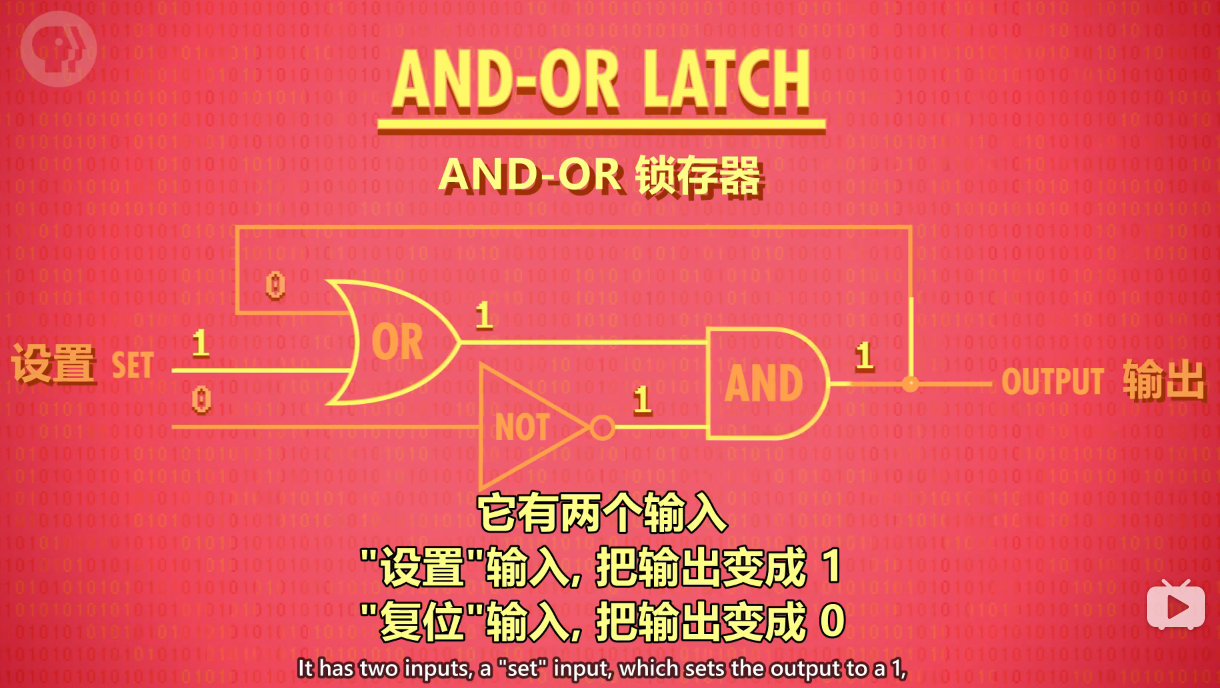
and a "reset" input, which resets the output to a 0.
复位输入,把输出变成0
If set and reset are both 0, the circuit just outputs whatever was last put in it.
如果"设置"和"复位"都是0,电路会输出最后放入的内容
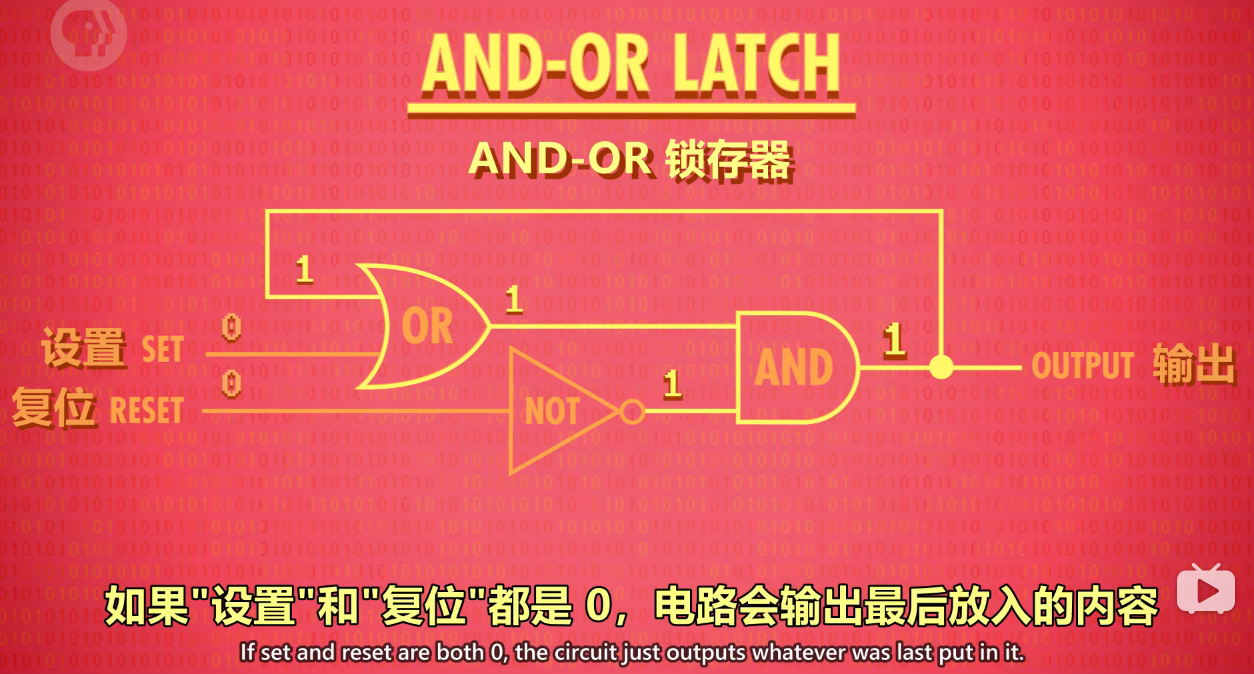
In other words, it remembers a single bit of information!
也就是说,它存住了1位的信息!
Memory!
存储!
This is called a "latch" because it "latches onto" a particular value and stays that way.
这叫"锁存",因为它"锁定"了一个值
The action of putting data into memory is called writing, whereas getting the data out is called reading.
放入数据的动作叫"写入",拿出数据的动作叫"读取"
Ok, so we've got a way to store a single bit of information!
现在我们终于有办法存一个位了!
Great!
超棒!
Unfortunately, having two different wires for input set and reset is a bit confusing.
麻烦的是,用两条线"设置"和"复位"来输入,有点难理解
To make this a little easier to use, we really want a single wire to input data,
为了更容易用,我们希望只有一条输入线
that we can set to either 0 or 1 to store the value.
将它设为0或1来存储值
Additionally, we are going to need a wire that enables the memory
还需要一根线来"启用"内存
to be either available for writing or "locked" down
启用时允许写入,没启用时就"锁定"
which is called the write enable line.
这条线叫"允许写入线"
By adding a few extra logic gates, we can build this circuit,
加一些额外逻辑门,可以做出这个电路
which is called a Gated Latch since the "gate" can be opened or closed.
这叫"门锁",因为门可以打开和关上
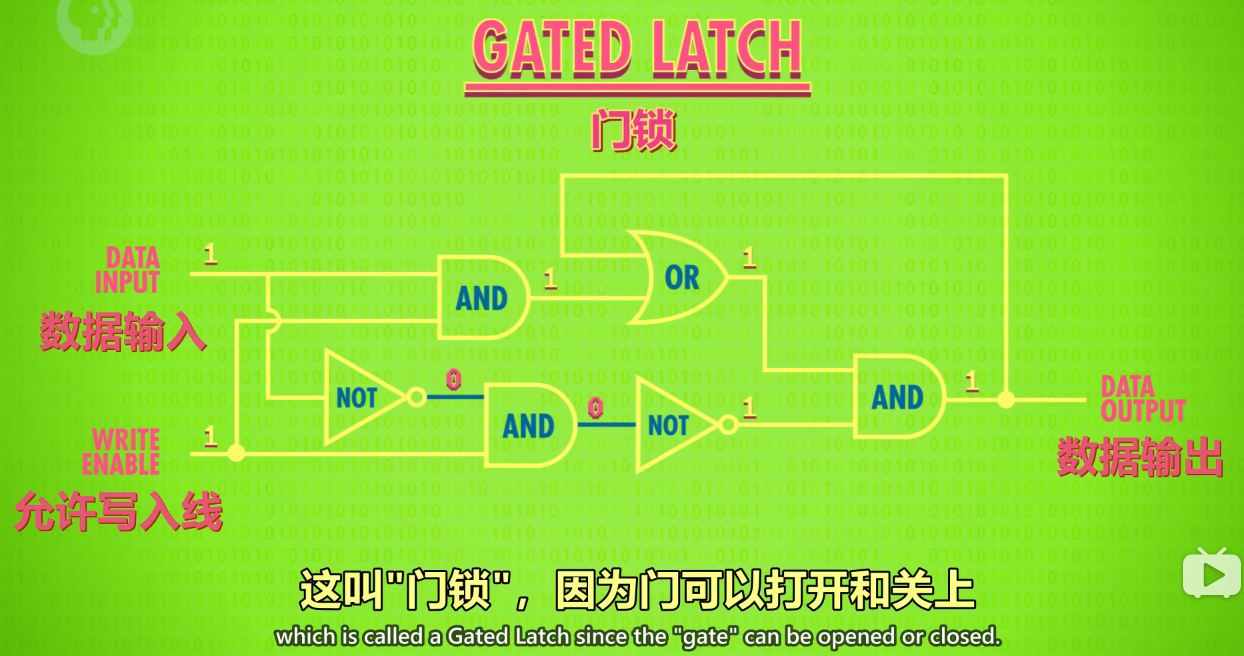
Now this circuit is starting to get a little complicated.
现在有点复杂了
We don't want to have to deal with all the individual logic gates...
我们不想关心单独的逻辑门
so as before, we're going to bump up a level of abstraction,
所以我们提升一层抽象
and put our whole Gated Latch circuit in a box -a box that stores one bit.
把"门锁"放到盒子里这个盒子能存一个bit
Let's test out our new component!
我们来测一下新组件!
Let's start everything at 0.
一切从0开始
If we toggle the Data wire from 0 to 1 or 1 to 0,
数据输入从0换到1,从1换到0
nothing happens the output stays at 0.
什么也不会发生输出依然是0
That's because the write enable wire is off, which prevents any change to the memory.
因为"允许写入线"是关闭的,所以内容不会变化
So we need to "open" the "gate" by turning the write enable wire to 1.
所以要给"允许写入线"输入1,"打开"门
Now we can put a 1 on the data line to save the value 1 to our latch.
现在往"数据线"放1,1就能存起来了
Notice how the output is now 1.
注意输出现在是1了
Now we can put a 1 on the data line to save the value 1 to our latch.
现在我们可以在数据线上加一个1,将值1保存到锁存器中。
Success!
成功!
We can turn off the enable line and the output stays as 1.
现在可以关掉"允许写入线",输出会保持1
Once again, we can toggle the value on the data line all we want,
现在不管给"数据线"什么值
but the output will stay the same.
输出都不会变
The value is saved in memory.
值存起来了
Now let's turn the enable line on again use our data line to set the latch to 0.
现在又打开"允许写入线","数据线"设为0
Done.
完成
Enable line off, and the output is 0.
允许写入线关闭,输出0
And it works!
成功了!
Now, of course, computer memory that only stores one bit of information isn't very useful
当然,只能存1bit没什么大用
definitely not enough to run Frogger.
肯定玩不了游戏
Or anything, really.
或做其它事情
But we're not limited to using only one latch.
但我们没限制只能用一个锁存器
If we put 8 latches side-by-side, we can store 8 bits of information like an 8-bit number.
如果我们并排放8个锁存器,可以存8位信息,比如一个8bit数字
A group of latches operating like this is called a register,
一组这样的锁存器叫"寄存器"
which holds a single number, and the number of bits in a register is called its width.
寄存器能存一个数字,这个数字有多少位,叫"位宽"
Early computers had 8-bit registers, then 16, 32,
早期电脑用8位寄存器,然后是16位,32位
and today, many computers have registers that are 64-bits wide.
如今许多计算机都有64位宽的寄存器
To write to our register, we first have to enable all of the latches.
写入寄存器前,要先启用里面所有锁存器
We can do this with a single wire that connects to all of their enable inputs, which we set to 1.
我们可以用一根线连接所有"允许输入线",把它设为1
We then send our data in using the 8 data wires, and then set enable back to 0,
然后用8条数据线发数据,然后将"允许写入线"设回0
and the 8 bit value is now saved in memory.
现在8位的值就存起来了
Putting latches side-by-side works ok for a small-ish number of bits.
如果只有很少的位(bits),把锁存器并排放置,也勉强够用了.
A 64-bit register would need 64 wires running to the data pins, and 64 wires running to the outputs.
64位寄存器要64根数据线,64根连到输出端
Luckily we only need 1 wire to enable all the latches, but that's still 129 wires.
幸运的是,我们只要1根线启用所有锁存器,但加起来也有129条线了
For 256 bits, we end up with 513 wires!
如果存256位要513条线!
The solution is a matrix!
解决方法是矩阵!
In this matrix, we don't arrange our latches in a row,
在矩阵中,我们不并列排放锁存器
we put them in a grid.
而是做成网格
For 256 bits, we need a 16 by 16 grid of latches with 16 rows and columns of wires.
存256位,我们用16x16网格的锁存器,有16行16列
To activate any one latch, we must turn on the corresponding row AND column wire.
要启用某个锁存器,就打开相应的行线和列线
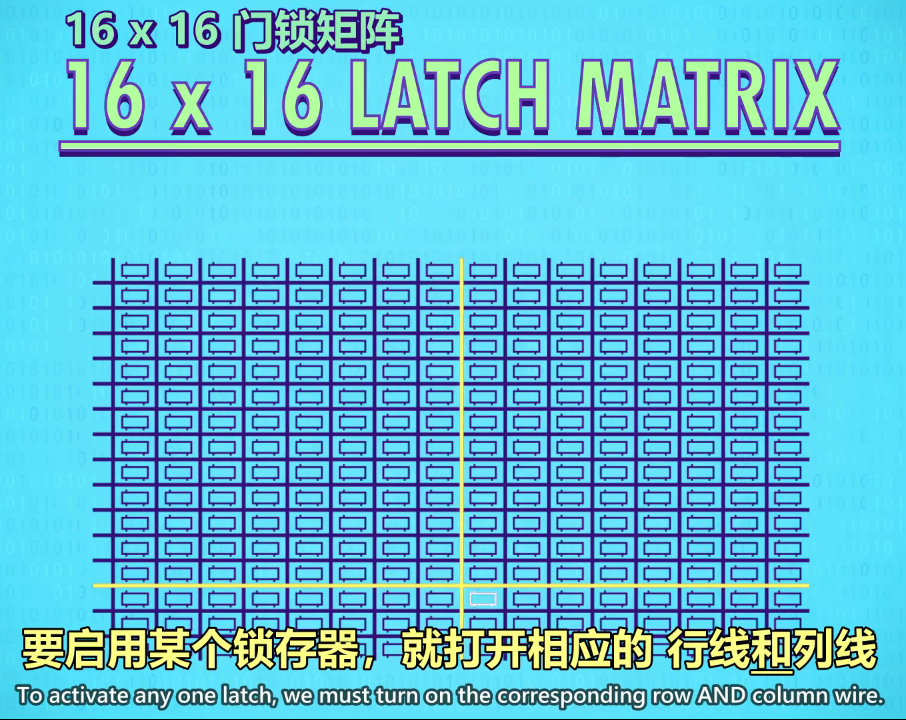
Let's zoom in and see how this works.
放大看看怎么做的
We only want the latch at the intersection of the two active wires to be enabled,
我们只想打开交叉处锁存器的"允许写入线"
but all of the other latches should stay disabled.
所有其他锁存器,保持关闭
For this, we can use our trusty AND gate!
我们可以用AND门!
The AND gate will output a 1 only if the row and the column wires are both 1.
只有行线和列线均为1,AND门才输出1
So we can use this signal to uniquely select a single latch.
所以可以用选择单个锁存器
This row/column setup connects all our latches with a single, shared, write enable wire.
这种行/列排列法,用一根"允许写入线"连所有锁存器
In order for a latch to become write enabled,
为了让锁存器变成"允许写入"
the row wire, the column wire, and the write enable wire must all be 1.
行线,列线和"允许写入线"都必须是1
That should only ever be true for one single latch at any given time.
每次只有1个锁存器会这样
This means we can use a single, shared wire for data.
代表我们可以只用一根"数据线",连所有锁存器来传数据
Because only one latch will ever be write enabled, only one will ever save the data
因为只有一个锁存器会启用,只有那个会存数据
the rest of the latches will simply ignore values on the data wire because they are not write enabled.
其他锁存器会忽略数据线上的值,因为没有"允许写入"
We can use the same trick with a read enable wire to read the data later,
我们可以用类似的技巧,做"允许读取线"来读数据
to get the data out of one specific latch.
从一个指定的锁存器,读取数据
This means in total, for 256 bits of memory,
所以对于256位的存储
we only need 35 wires 1 data wire, 1 write enable wire, 1 read enable wire,
只要35条线,1条"数据线",1条"允许写入线",1条"允许读取线"
and 16 rows and columns for the selection.
还有16行16列的线用于选择锁存器,(16+16=32,32+3=35)
That's significant wire savings!
这省了好多线!
But we need a way to uniquely specify each intersection.
但我们需要某种方法来唯一指定交叉路口
We can think of this like a city,
我们可以想成城市
where you might want to meet someone at 12th avenue and 8th street
你可能想和别人在第12大道和第8街的交界碰面
that's an address that defines an intersection.
这是一个交叉点的地址
The latch we just saved our one bit into has an address of row 12 and column 8.
我们刚刚存了一位的地址是"12行8列"
Since there is a maximum of 16 rows, we store the row address in a 4 bit number.
由于最多16行,用4位就够了
12 is 1100 in binary.
12用二进制表示为1100
We can do the same for the column address: 8 is 1000 in binary.
列地址也可以这样:8用二进制表示为1000
So the address for the particular latch we just used can be written as 11001000.
刚才说的"12行8列"可以写成11001000
To convert from an address into something that selects the right row or column,
为了将地址转成行和列
we need a special component called a multiplexer
我们需要"多路复用器"
which is the computer component with a pretty cool name at least compared to the ALU.
这个名字起码比ALU酷一点
Multiplexers come in all different sizes,
多路复用器有不同大小
but because we have 16 rows, we need a 1 to 16 multiplexer.
因为有16行,我们需要1到16多路复用器
It works like this.
工作方式是
You feed it a 4 bit number, and it connects the input line to a corresponding output line.
输入一个4位数字,它会把那根线,连到相应的输出线
So if we pass in 0000, it will select the very first column for us.
如果输入0000,它会选择第一列
If we pass in 0001, the next column is selected, and so on.
如果输入0001,会选择下一列,依此类推
We need one multiplexer to handle our rows and another multiplexer to handle the columns.
一个多路复用器处理行(row),另一个多路复用器处理列(column)
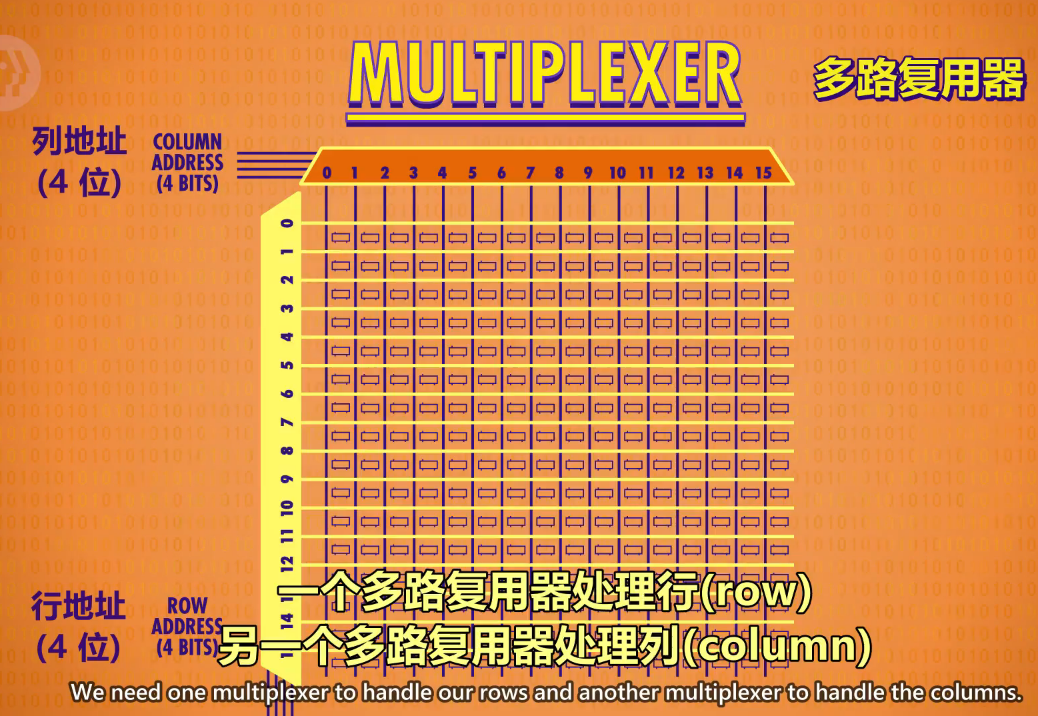
Ok, it's starting to get complicated again,
好吧,开始有点复杂了
so let's make our 256-bit memory its own component.
那么把256位内存当成一个整体好了
Once again a new level of abstraction!
又提升了一层抽象!
It takes an 8-bit address for input the 4 bits for the column and 4 for the row.
它输入一个8位地址:4位代表列,4位代表行
We also need write and read enable wires.
我们还需要"允许写入线"和"允许读取线"
And finally, we need just one data wire, which can be used to read or write data.
最后,还需要一条数据线,用于读/写数据

Unfortunately, even 256-bits of memory isn't enough to run much of anything,
不幸的是,256位的内存也没法做什么事
so we need to scale up even more!
所以还要扩大规模
We're going to put them in a row.
把它们并排放置
Just like with the registers.
就像寄存器一样
We'll make a row of 8 of them, so we can store an 8 bit number also known as a byte.
一行8个,可以存一个8位数字,8位也叫一个字节(byte)
To do this, we feed the exact same address into all 8 of our 256-bit memory components at the same time,
为了存一个8位数字,我们同时给8个256位内存一样的地址
and each one saves one bit of the number.
每个地址存1位
That means the component we just made can store 256 bytes at 256 different addresses.
意味着这里总共能存256个字节(byte)

Again, to keep things simple, we want to leave behind this inner complexity.
再次,为了简单,我们不管内部
Instead of thinking of this as a series of individual memory modules and circuits,
不看作是一堆独立的存储模块和电路
we'll think of it as a uniform bank of addressable memory.
而是看成一个整体的可寻址内存
We have 256 addresses,
我们有256个地址
and at each address, we can read or write an 8-bit value.
每个地址能读或写一个8位值
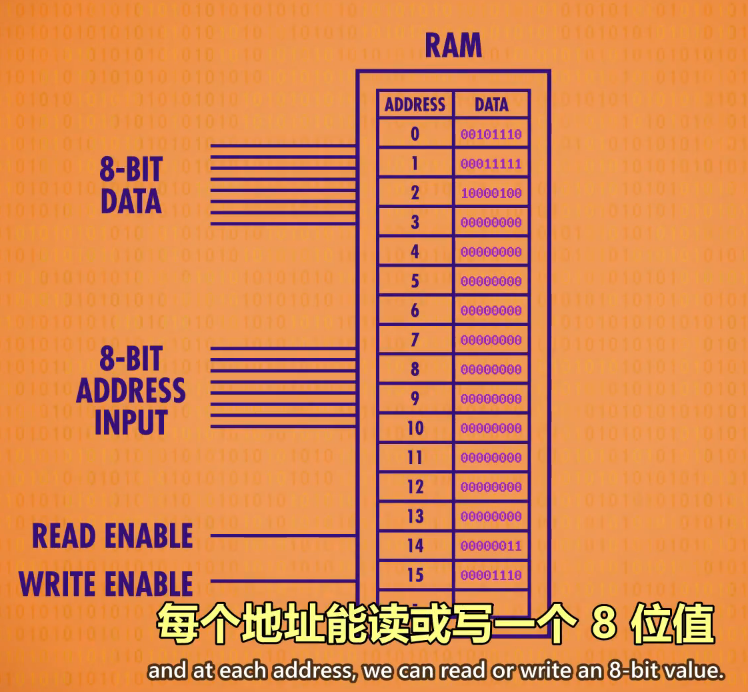
We're going to use this memory component next episode when we build our CPU.
我们下集做CPU时会用到这个内存
The way that modern computers scale to megabytes and gigabytes of memory
现代计算机的内存,扩展到上兆字节(MB)和千兆字节(GB)的方式
is by doing the same thing we've been doing here
和我们这里做的一样
keep packaging up little bundles of memory into larger, and larger, and larger arrangements.
不断把内存打包到更大规模
As the number of memory locations grow, our addresses have to grow as well.
随着内存地址增多,内存地址也必须增长
8 bits hold enough numbers to provide addresses for 256 bytes of our memory,
8位最多能代表256个内存地址,(11111111是255,0~255一共256个数字)
but that's all.
只有这么多
To address a gigabyte or a billion bytes of memory we need 32-bit addresses.
要给千兆或十亿字节的内存寻址,需要32位的地址
An important property of this memory is that we can access any memory location, at any time, and in a random order.
内存的一个重要特性是:可以随时访问任何位置
For this reason, it's called Random-Access Memory or RAM.
因此叫"随机存取存储器",简称RAM
When you hear people talking about how much RAM a computer has
当你听到有人说RAM有多大
that's the computer's memory.
他的意思是内存有多大
RAM is like a human's short term or working memory,
RAM就像人类的短期记忆
where you keep track of things going on right now
记录当前在做什么事
like whether or not you had lunch or paid your phone bill.
比如吃了午饭没,或有没有交电话费
Here's an actual stick of RAM with 8 memory modules soldered onto the board.
这是一条真的内存,上面焊了8个内存模块
If we carefully opened up one of these modules and zoomed in,
如果打开其中一个,然后放大
The first thing you would see are 32 squares of memory.
会看到32个内存方块
Zoom into one of those squares, and we can see each one is comprised of 4 smaller blocks.
放大其中一个方块,可以看到有4个小块
If we zoom in again, we get down to the matrix of individual bits.
如果再放大,可以看到存一个"位"的矩阵
This is a matrix of 128 by 64 bits.
这个矩阵是128位x64位
That's 8192 bits in total.
总共8192位
Each of our 32 squares has 4 matrices, so that's 32 thousand, 7 hundred and 68 bits.
每个方格4个矩阵,所以一个方格有32768个位(8192x4=32768)
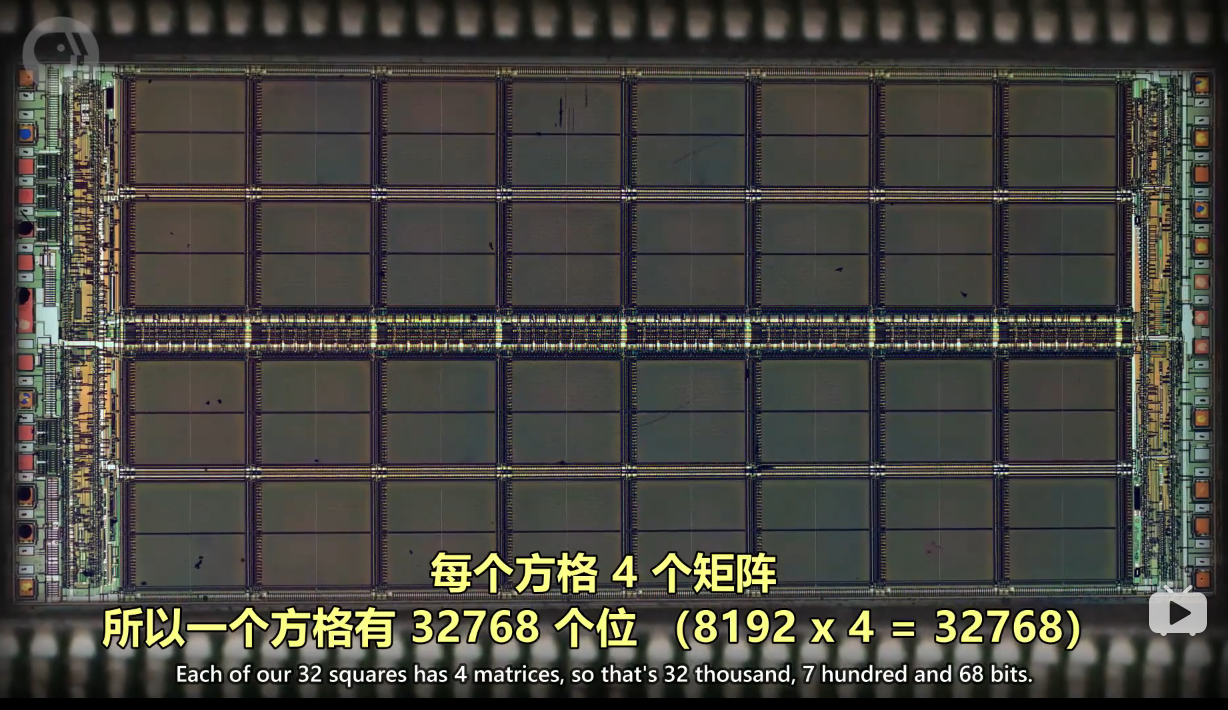
And there are 32 squares in total.
而一共32个方格
So all in all, that's roughly 1 million bits of memory in each chip.
总而言之,1个芯片大约存100万位
Our RAM stick has 8 of these chips, so in total, this RAM can store 8 millions bits,
RAM有8个芯片,所以总共800万位
otherwise known as 1 megabyte.
也就是1兆字节(1MB)
That's not a lot of memory these days -this is a RAM module from the 1980's.
1MB如今不算大这是1980年代的RAM
Today you can buy RAM that has a gigabyte or more of memory
如今你可以买到千兆字节(GB)的RAM
that's billions of bytes of memory.
那可是数十亿字节的内存
So, today, we built a piece of SRAM Static Random-Access Memory which uses latches.
今天,我们用锁存器做了一块SRAM(静态随机存取存储器)
There are other types of RAM, such as DRAM, Flash memory, and NVRAM.
还有其他类型的RAM,如DRAM,闪存和NVRAM
These are very similar in function to SRAM,
它们在功能上与SRAM相似
but use different circuits to store the individual bits
但用不同的电路存单个位
for example, using different logic gates, capacitors, charge traps, or memristors.
比如用不同的逻辑门,电容器,电荷捕获或忆阻器
But fundamentally, all of these technologies store bits of information
但根本上这些技术都是矩阵层层嵌套,
in massively nested matrices of memory cells.
来存储大量信息
Like many things in computing, the fundamental operation is relatively simple.
就像计算机中的很多事情,底层其实都很简单
it's the layers and layers of abstraction that's mind blowing
让人难以理解的,是一层层精妙的抽象
like a russian doll that keeps getting smaller and smaller and smaller.
像一个越来越小的俄罗斯套娃
I'll see you next week.
下周见